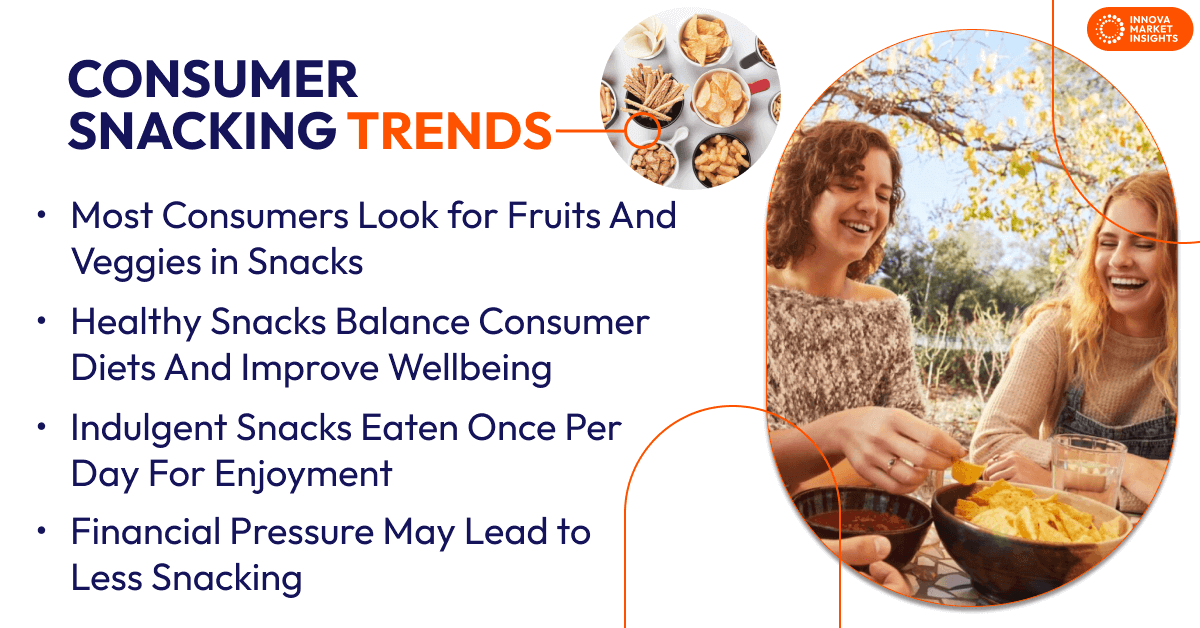February 9, 2024 – People love snacking. There are multiple consumer viewpoints that influence where, when, and why they snack, when they like to have sweet snacks or savory snacks, and how healthier snacks can fit into their day. And of course, children’s snacking habits, and the choices parents make for them, also impact the market. Tracking global snacking trends is an ongoing process, and continued research reveals key insights into the category.
Consumers Enjoy Snacks At Least Once a Day
Consumers snacking trends data show that over two-thirds of consumers globally snack at least once a day. Many reasons contribute to snacking, including hunger, cravings, and boredom, especially when consumers are at home. When they’re done snacking, consumers say that they feel happiness and comfort. A majority of consumers in all global regions – North America, Latin America, Europe, Asia, the Middle East and Africa, Australasia – say they buy snacks at a grocery store or supermarket.
Better-For-You Snacks are Popular
Consumers enjoy better-for-you snacks. For instance, fruit and vegetable snacks are the top choice of about 60% of consumers globally. These healthier snacks rank ahead of salty savory snacks and sweet snacks such as biscuits and cookies. Consumer snacking trends show differences among countries, with two-thirds of Brazilian consumers naming fruit and vegetables as their top snack while nearly two-thirds of Canadian consumers prefer salty and savory snacks.
Consumers choose different types of snacks at different times of day. Healthier snacks are particularly popular in the morning. In the afternoon, when the highest proportion of consumers say they snack, convenience is the top snacking priority. Indulgent snacks are most popular in the evening.

Healthy Snacks Are on the Rise
According to Innova’s consumer snacking trends, one-third of consumers globally, report increasing their consumption of healthy snacks over the past year, led by consumers in India and China. In contrast, half as many say that they increased indulgent snacks. India again is a leading country for indulgence, followed by Indonesia.
Consumers Eat Healthy Snacks for a Balanced Diet and to Feel Better Physically
Consumer snacking trends show consumers’ efforts to balance their snacking. When picking snacks, about one-half report choosing a healthier alternative and one-quarter choose the indulgent choice. Most consumers say they eat healthy snacks for a balanced diet and to feel better physically. The top attribute consumers look for in a healthy snack is no additives or preservatives, followed by no artificial ingredients.
Better-for-you snacks are more likely to be savory snacks versus sweet snacks, and the favorite savory snack is nuts and seeds. Savory nuts and seeds are especially popular in Indonesia, Mexico, Spain, and China. Another savory snack subcategory, dairy snacks, are chosen more often by consumers in China, Indonesia, India, and Canada.
Indulgent Snacks Are Enjoyable
The highest proportion of consumers globally snack on indulgent snacks once per day, mainly for enjoyment and pleasure. They say that the rich flavor and taste of snacks such as sweet biscuits and cookies; cakes, pastries, and sweet goods; and chocolate confectionery is what makes them indulgent.
Children Snack While Adults Make Snacking Decisions
Children are frequent snackers, but adults are the decision makers according to Innova’s consumer snacking trends data. About half of adults globally say that they are completely responsible for buying snacks for their children. Snacking is even more prevalent among children. Seven in 10 global respondents say that their child or children snack at least once a day or more, and the proportion is higher in North America and Asia.
Around one-third of consumers note that healthiness was the most important factor in snacks for children and they support healthy snacking for children by buying and serving fruit and vegetables. Sweet snacks of biscuits and cookies and savory snacks of dairy also are popular. Of course, flavor is important too.
What’s Next for Snacking?
In addition to future health and personal attitudes as motivators and drivers for snacking and healthier snacking, various other factors also could influence future behavior. Consumer groups that are under financial pressure and are sensitive to high prices for food and beverage may be trying to spend less on snacks and other treat foods. Consumers in West Europe and North America are especially vulnerable to financial pressures. Financial situations also affect the types of snacks purchased. Consumer trends data show that shoppers in the UK, France, and the US are more likely to buy lower-priced snacks while those in China and Mexico are more apt to purchase premium snacks.
Sustainability is another influence on snacks and snacking. One in five consumers globally increased their purchases of sustainable snack foods over a recent 12-month period, led by consumers in India, Indonesia, China, and Brazil. However, financial pressures on consumers in North America and West Europe may be dampening their purchases of sustainable snacks.
This article is based on our report, “Exploring Global Trends & Emerging Opportunities in Snacking Consumer Preferences.”
If you are interested in receiving this report, feel free to request a demo through our Contact Form.